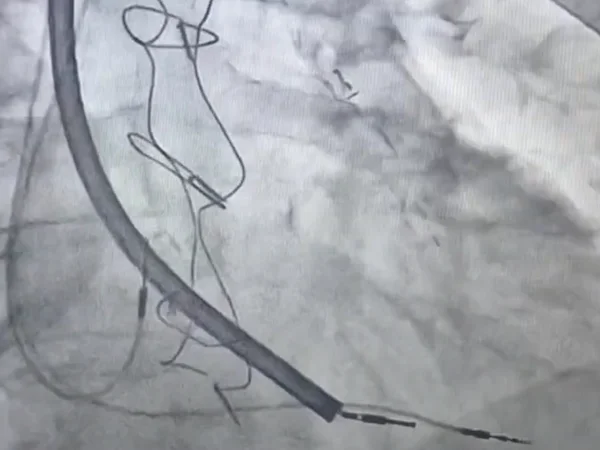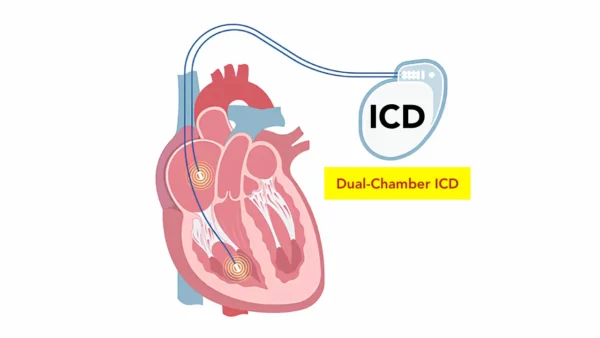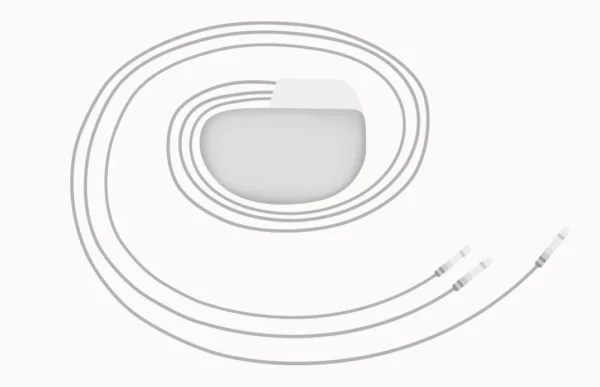A cardiac pacemaker is a small electronic device about the size of a large coin implanted under the skin of your chest to help control your heartbeat. When your heart beats too slowly or misses beats, the pacemaker sends electrical pulses to keep your rhythm normal.
Overview
A pacemaker is a small device containing a battery, a tiny computer, and thin wires that connect to your heart. It sits under the skin just below your collarbone.
The device constantly monitors your heart’s electrical activity and only sends signals when needed. If your heart beats too slowly or skips beats, the pacemaker steps in to maintain a normal rhythm.
Modern pacemakers are smart—they adjust to your activity level. When you exercise, they speed up your heart rate. When you rest, they slow it down. This happens automatically without you thinking about it.
The battery typically lasts 5-15 years depending on how often the device needs to work. When the battery runs low, a simple procedure replaces the device while the wires usually stay in place.
Once implanted, the pacemaker works silently in the background. Most people forget they have it and live completely normal, active lives.
Why You Might Need One
Doctors recommend pacemakers when your heart’s electrical system causes problems affecting your quality of life or health.
- The most common reason is bradycardia—when your heart beats too slowly. While normal resting heart rate is 60-100 beats per minute, bradycardia means your heart beats slower than 60. This slow rhythm can leave your brain and organs without enough oxygen-rich blood.
- Heart block is another major reason. This happens when electrical signals can’t travel properly from your heart’s upper chambers to lower chambers. Complete heart block means the upper and lower chambers beat independently, causing fatigue, dizziness, and fainting.
- Aging naturally affects your heart’s electrical system. As you get older, tissue that generates electrical signals can wear out. This is why pacemakers are most common in people over 65, though younger people sometimes need them.
- Some medications for blood pressure and heart disease slow your heart as a side effect. If you need these medications but they make your heart beat dangerously slowly, a pacemaker lets you continue treatment safely.
- Fainting spells from sudden drops in heart rate can be dangerous. These episodes happen without warning, risking injury from falls. A pacemaker prevents these situations.
Preparing for the Procedure
Once your doctor recommends a pacemaker, you’ll have several tests.
- An electrocardiogram records your heart’s electrical activity. An echocardiogram uses sound waves to create images of your heart. You may wear a monitor for 24-48 hours tracking your rhythm during daily activities.
- Blood tests check your kidney function, liver function, and blood clotting ability.
- If you take blood thinners, your doctor provides specific instructions about adjusting them. Never stop medications without asking your doctor first.
- About a week before, tell your doctor about all medications you take, including vitamins and supplements.
- Stop eating and drinking after midnight the night before. Your doctor may allow certain medications with a small sip of water in the morning.
- Arrange for someone to drive you to the hospital and home afterward. You can’t drive for 24 hours after the procedure.
- Pack an overnight bag with comfortable clothing and toiletries. Most people stay one night. Wear comfortable, loose-fitting clothes that button in front—this makes dressing easier afterward without raising your arms.
The Procedure
Pacemaker implantation takes 1-3 hours and doesn’t require general anesthesia. You’re awake but relaxed.
- You receive medication through an IV to help you relax. This makes you drowsy and calm, but you can still respond to instructions.
- The area below your collarbone is cleaned and covered with sterile drapes. Your doctor injects local anesthetic to numb the area completely. You’ll feel a small pinch, then nothing.
- Your doctor makes a small incision about 2-3 inches long, creating a pocket for the pacemaker device.
- Using X-ray guidance, your doctor threads one or two thin, flexible wires through a vein near your collarbone. These wires travel through the vein into your heart. The X-ray images show exactly where the wires are positioned.
- The wires are placed in specific chambers of your heart depending on your condition. The tips have tiny anchors that attach gently to your heart muscle.
- Your doctor tests the wires to ensure they’re sensing your heart’s signals and can deliver electrical pulses effectively.
- After confirming everything works, your doctor connects the wires to the pacemaker device and programs it specifically for your needs. The device is placed in the pocket under your skin.
- Finally, your doctor closes the incision with stitches or surgical glue and covers it with a sterile dressing.
- Throughout, nurses monitor your heart rhythm, blood pressure, and oxygen levels. Most people feel only mild pressure or pulling sensations, not pain.
After the Procedure
- After implantation, you spend time in recovery where nurses monitor you. You need to lie relatively flat for several hours to prevent bleeding and allow the wires to settle.
- You might feel soreness at the incision site. Pain medication helps. The area may look bruised or swollen—this is normal and resolves within 1-2 weeks. Your shoulder and arm on that side might feel stiff.
- Before leaving, a technician checks your pacemaker settings. This quick, painless check ensures everything works properly.
- You’ll receive a pacemaker identification card with important information about your device. Keep this card in your wallet always.
- Most people go home the next day. Someone needs to drive you home.
Recovery at Home
The first week focuses on allowing the incision to heal and the wires to settle firmly.
- Keep the incision site clean and dry. You can shower after 48 hours but avoid baths, hot tubs, or swimming for at least 2 weeks.
- Don’t raise your arm on the pacemaker side above shoulder height for 4-6 weeks. This prevents the wires from dislodging. You can use your arm normally for eating, writing, and light tasks, but avoid reaching overhead or lifting heavy objects.
- Pain should gradually improve. Most people feel much better within a few days. Over-the-counter pain relievers usually help.
- Stitches are typically removed 7-10 days after the procedure. Dissolvable stitches disappear on their own. Once healed, you’ll have a small scar that fades over time.
- Gradually increase your activity. Start with short walks and slowly return to your normal routine. Most people return to work within a week, depending on their job.
- Your first follow-up appointment happens 2-4 weeks after implantation. Your doctor checks the incision, reviews symptoms, and adjusts settings if needed. After that, you have checkups every 3-6 months.
Living with a Pacemaker
Modern pacemakers let most people return to all normal activities. However, be aware of certain devices that can interfere with it.
- Most household appliances are safe—microwaves, televisions, radios, electric blankets, and computers. Cell phones are safe but keep yours at least 6 inches from your pacemaker. Don’t carry it in a shirt pocket over your pacemaker.
- Security systems at airports won’t harm your pacemaker, but the metal may trigger detectors. Show your ID card to security. You can request a hand search.
- Many newer pacemakers are safe for MRI scans under specific conditions. Always tell healthcare providers you have a pacemaker before any procedure.
- Exercise is encouraged. Once healed, you can return to most activities—walking, swimming, cycling, and golf are all fine. Avoid contact sports that could result in chest blows. Discuss specific plans with your doctor.
- You can drive once cleared by your doctor, usually within a week. Flying is safe. You can have sex once comfortable, typically within a week.
When to Call Your Doctor
- Contact your doctor immediately if you notice signs of infection—increasing redness, swelling, warmth, drainage, or red streaks from the incision. Fever above 100.4°F also suggests infection.
- Seek emergency care for chest pain, especially if severe or with shortness of breath, sweating, or nausea.
- Call your doctor if you develop symptoms suggesting your pacemaker isn’t working—dizziness, fainting, unusual fatigue, or return of symptoms you had before. Persistent hiccups or muscle twitching in your chest might mean a wire moved.
- If you notice swelling, pain, or changes in how the pacemaker site looks or feels, contact your doctor. The device should sit flat under your skin.
- Before any medical or dental procedure, inform the provider about your pacemaker.
- Never miss scheduled pacemaker checkups. These allow your doctor to assess battery life, check wire function, and adjust settings.
Key Points
- A pacemaker is a small device implanted under your chest skin that helps control your heartbeat when your heart’s natural system malfunctions.
- You might need one if your heart beats too slowly, if electrical signals can’t travel properly through your heart, or if you have fainting spells from heart rhythm problems.
- The implantation procedure takes 1-3 hours. You’re awake but sedated. Your doctor makes a small incision, threads thin wires through a vein to your heart, connects them to the pacemaker device, and places it under your skin.
- Most people go home the next day. Recovery focuses on letting the incision heal and wires settle for 4-6 weeks. Don’t raise your arm above shoulder height during this time.
- The battery lasts 5-15 years. Regular checkups every 3-6 months ensure everything works properly.
- Most household appliances are safe. Keep cell phones at least 6 inches from your pacemaker. Security systems won’t harm it, though metal may trigger detectors.
- Exercise is encouraged once healed. You can return to most activities including walking, swimming, and cycling. Avoid contact sports.
- Contact your doctor for signs of infection, chest pain, or symptoms suggesting your pacemaker isn’t working properly. Never miss scheduled checkups.
- With a pacemaker, most people live completely normal, active lives. The device works silently in the background, allowing you to forget about it while it keeps your heart beating regularly.
You may also like to read these:
Three-chamber pacemaker (biventricular or CRT)
Implantable cardioverter-defibrillator (ICD)
Reference: Pacemakers




